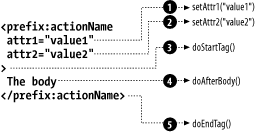Developing an Iterating Action
As I alluded
to earlier, a
tag handler can ask the container to
evaluate the action element’s body repeatedly until
some condition is true. For each evaluation, the
result can be different because variables used in the body may change
their values. An example of an iterating action is the JSTL
<c:forEach> action. It can iterate over the
element’s body once for each element in a
collection.
A tag handler that evaluates its body repeatedly implements the
IterationTag
interface, which contains only one
method:
-
public int doAfterBody( ) throws JspException Called by the container after it has processed the action element’s body.
If you have worked with JSP 1.1 previously, this method may look
familiar. It was part of the BodyTag interface in
JSP 1.1 but was moved to the new IterationTag
interface in JSP 1.2 to provide for a more efficient handling of
iteration actions that don’t need access to their
element body.
A tag handler that implements the IterationTag
interface is at first handled the same way as a tag handler
implementing the Tag interface: the container
calls all property setter methods and the doStartTag( ) method. Then things divert slightly, as illustrated in
Figure 20-3.

Figure 20-3. IterationTag interface methods
After the call to doStartTag( ), the
doAfterBody( ) method may be called before the
doEndTag( ) method is finally called. ...
Get JavaServer Pages, Second Edition now with the O’Reilly learning platform.
O’Reilly members experience books, live events, courses curated by job role, and more from O’Reilly and nearly 200 top publishers.

